Natural thioallyl compounds increase oxidative stress resistance and lifespan in Caenorhabditis elegans by modulating SKN-1/Nrf
- PMID: 26899496
- PMCID: PMC4761942
- DOI: 10.1038/srep21611
Natural thioallyl compounds increase oxidative stress resistance and lifespan in Caenorhabditis elegans by modulating SKN-1/Nrf
Abstract
Identification of biologically active natural compounds that promote health and longevity, and understanding how they act, will provide insights into aging and metabolism, and strategies for developing agents that prevent chronic disease. The garlic-derived thioallyl compounds S-allylcysteine (SAC) and S-allylmercaptocysteine (SAMC) have been shown to have multiple biological activities. Here we show that SAC and SAMC increase lifespan and stress resistance in Caenorhabditis elegans and reduce accumulation of reactive oxygen species (ROS). These compounds do not appear to activate DAF-16 (FOXO orthologue) or mimic dietary restriction (DR) effects, but selectively induce SKN-1 (Nrf1/2/3 orthologue) targets involved in oxidative stress defense. Interestingly, their treatments do not facilitate SKN-1 nuclear accumulation, but slightly increased intracellular SKN-1 levels. Our data also indicate that thioallyl structure and the number of sulfur atoms are important for SKN-1 target induction. Our results indicate that SAC and SAMC may serve as potential agents that slow aging.
Figures




Similar articles
-
Rhodiola extract promotes longevity and stress resistance of Caenorhabditis elegans via DAF-16 and SKN-1.Food Funct. 2021 May 21;12(10):4471-4483. doi: 10.1039/d0fo02974b. Epub 2021 Apr 21. Food Funct. 2021. PMID: 33881421
-
The SKN-1/Nrf2 transcription factor can protect against oxidative stress and increase lifespan in C. elegans by distinct mechanisms.Aging Cell. 2017 Oct;16(5):1191-1194. doi: 10.1111/acel.12627. Epub 2017 Jun 14. Aging Cell. 2017. PMID: 28612944 Free PMC article.
-
Glochidion zeylanicum leaf extracts exhibit lifespan extending and oxidative stress resistance properties in Caenorhabditis elegans via DAF-16/FoxO and SKN-1/Nrf-2 signaling pathways.Phytomedicine. 2019 Nov;64:153061. doi: 10.1016/j.phymed.2019.153061. Epub 2019 Jul 31. Phytomedicine. 2019. PMID: 31401497
-
The search for DAF-16/FOXO transcriptional targets: approaches and discoveries.Exp Gerontol. 2006 Oct;41(10):910-21. doi: 10.1016/j.exger.2006.06.040. Epub 2006 Aug 24. Exp Gerontol. 2006. PMID: 16934425 Review.
-
SKN-1/Nrf, stress responses, and aging in Caenorhabditis elegans.Free Radic Biol Med. 2015 Nov;88(Pt B):290-301. doi: 10.1016/j.freeradbiomed.2015.06.008. Epub 2015 Aug 5. Free Radic Biol Med. 2015. PMID: 26232625 Free PMC article. Review.
Cited by
-
Phosphatidylcholine Extends Lifespan via DAF-16 and Reduces Amyloid-Beta-Induced Toxicity in Caenorhabditis elegans.Oxid Med Cell Longev. 2019 Jul 11;2019:2860642. doi: 10.1155/2019/2860642. eCollection 2019. Oxid Med Cell Longev. 2019. PMID: 31379987 Free PMC article.
-
Prolonged Lifespan, Improved Perception, and Enhanced Host Defense of Caenorhabditis elegans by Lactococcus cremoris subsp. cremoris.Microbiol Spectr. 2022 Jun 29;10(3):e0045421. doi: 10.1128/spectrum.00454-21. Epub 2022 May 16. Microbiol Spectr. 2022. PMID: 35575499 Free PMC article.
-
Sonneradon A Extends Lifespan of Caenorhabditis elegans by Modulating Mitochondrial and IIS Signaling Pathways.Mar Drugs. 2022 Jan 8;20(1):59. doi: 10.3390/md20010059. Mar Drugs. 2022. PMID: 35049915 Free PMC article.
-
BACH1 mediates the antioxidant properties of aged garlic extract.Exp Ther Med. 2020 Feb;19(2):1500-1503. doi: 10.3892/etm.2019.8380. Epub 2019 Dec 27. Exp Ther Med. 2020. PMID: 32010329 Free PMC article. Review.
-
Ferulic Acid Supplementation Increases Lifespan and Stress Resistance via Insulin/IGF-1 Signaling Pathway in C. elegans.Int J Mol Sci. 2021 Apr 20;22(8):4279. doi: 10.3390/ijms22084279. Int J Mol Sci. 2021. PMID: 33924155 Free PMC article.
References
-
- Fridovich I. Fundamental aspects of reactive oxygen species, or what’s the matter with oxygen? Ann. N. Y. Acad. Sci. 893, 13–18 (1999). - PubMed
-
- Leung H. W., Vang M. J. & Mavis R. D. The cooperative interaction between vitamin E and vitamin C in suppression of peroxidation of membrane phospholipids. Biochim. Biophys. Acta. 664, 266–272 (1981). - PubMed
-
- Guerrero-Beltrán C. E., Calderón-Oliver M., Pedraza-Chaverri J. & Chirino Y. I. Protective effect of sulforaphane against oxidative stress: recent advances. Exp. Toxicol. Pathol. 64, 503–508 (2012). - PubMed
-
- Sumiyoshi H. & Wargovich M. J. Garlic (Allium sativum): a review of its relationship to cancer. Asia Pacific J. Pharmacol. 4, 133–140 (1989).
-
- Makheja A. N., Vanderhoek J. Y. & Bailey J. M. Inhibition of platelet aggregation and thromboxane synthesis by onion and garlic. Lancet 1, 781 (1979). - PubMed
Publication types
MeSH terms
Substances
Grants and funding
LinkOut - more resources
Full Text Sources
Other Literature Sources
Medical
Miscellaneous

